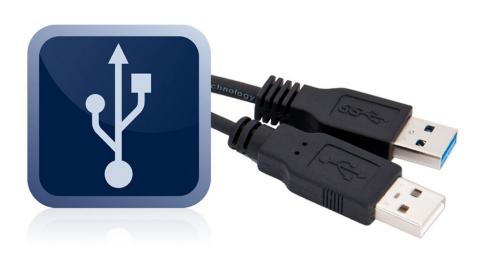Universal Serial Bus (USB) is an industry-standard interface that defines the cables, connectors, protocols, and power specifications used in communication between computers and peripherals. USB was designed to simplify device connectivity by replacing a variety of legacy ports with a universal connection standard.
Overview
-
Full Name: Universal Serial Bus
-
First Introduced: January 1996
-
Maintained By: USB-IF (USB Implementers Forum)
-
Primary Goals:
-
Simplify connections between computers and external devices
-
Provide plug-and-play support
-
Enable hot-swapping (devices can be plugged/unplugged while running)
-
USB Generations and Speeds
| Specification | Year Released | Max Data Rate | Connector Types |
|---|---|---|---|
| USB 1.0 | 1996 | 1.5 Mbps (Low-Speed), 12 Mbps (Full-Speed) | Type-A, Type-B |
| USB 2.0 | 2000 | 480 Mbps (High-Speed) | Type-A, Type-B, Mini, Micro |
| USB 3.0 (3.1 Gen 1) | 2008 | 5 Gbps (SuperSpeed) | Type-A, Type-B, Micro-B |
| USB 3.1 (Gen 2) | 2013 | 10 Gbps (SuperSpeed+) | Type-A, Type-C |
| USB 3.2 | 2017 | 20 Gbps (with dual-lane Type-C) | Type-C |
| USB4 | 2019 | 40 Gbps (shared with Thunderbolt 3) | Type-C |
| USB4 v2.0 | 2022 | 80 Gbps (up to 120 Gbps asymmetric) | Type-C |
Connector Types
Type-A
-
The original flat rectangular connector.
-
Still widely used on computers, chargers, and peripherals.
Type-B
-
Square-ish, used for printers and some older devices.
Mini-USB
-
Smaller variant, used in older cameras and MP3 players.
Micro-USB
-
Common in Android devices until USB-C replaced it.
USB-C
-
Reversible, compact, and capable of carrying data, power, and video.
-
Now the standard for most modern devices including phones, laptops, and docks.
USB Power Delivery (PD)
USB supports both data and power transfer, which evolved significantly over generations:
-
USB 2.0: Up to 2.5W (5V @ 500mA)
-
USB 3.0/3.1: Up to 4.5W (5V @ 900mA)
-
USB Battery Charging Spec: Up to 7.5W (5V @ 1.5A)
-
USB Power Delivery (USB PD):
-
Introduced with USB-C
-
Delivers up to 100W (20V @ 5A)
-
USB PD 3.1 supports up to 240W (48V @ 5A), enabling power delivery for laptops, monitors, and even small appliances.
-
Key Features
-
Plug and Play: Automatic device recognition and configuration.
-
Hot Swapping: Devices can be added or removed without rebooting.
-
Device Enumeration: The host system assigns addresses and resources dynamically.
-
Host-Device Model: USB requires a host controller (usually a PC or hub); devices are peripherals only.
USB Host, Hub, and Device Roles
-
Host: Initiates communication and manages data transfer (usually a PC or smartphone).
-
Hub: Expands one USB port into multiple ports; may be powered or unpowered.
-
Device: Receives commands and may send/receive data (mouse, keyboard, camera, storage, etc.).
Common USB Classes
USB supports a wide variety of device classes, each with standardized drivers:
| Class | Examples |
|---|---|
| HID (Human Interface Device) | Keyboards, Mice, Gamepads |
| MSC (Mass Storage Class) | Flash drives, External HDDs |
| CDC (Communications Device Class) | Modems, Serial interfaces |
| UVC (USB Video Class) | Webcams, Video capture devices |
| UAC (USB Audio Class) | Microphones, Headsets, Speakers |
USB vs. Thunderbolt vs. Other Interfaces
| Feature | USB 3.2 Gen 2×2 | USB4 | Thunderbolt 4 |
|---|---|---|---|
| Max Speed | 20 Gbps | 40–80 Gbps | 40 Gbps |
| Power Delivery | Up to 100W (240W for PD 3.1) | Up to 240W | Up to 100W |
| Display Support | Limited (USB-C Alt Mode) | Yes (Alt Mode) | Yes (full PCIe + DisplayPort) |
| Backward Compatibility | Full | Full | With USB-C and Thunderbolt |
USB OTG (On-The-Go)
USB OTG allows devices like smartphones to act as hosts to connect other USB peripherals (e.g., a phone acting as a host to a USB flash drive or keyboard).
Security Considerations
-
USB is vulnerable to attacks like BadUSB, USB-based malware, and power surge damage.
-
USB firewalls and USB port management software are used in enterprise environments.
Future of USB
-
USB4 v2.0 enables 80–120 Gbps, targeting applications like AR/VR, external GPUs, and 8K displays.
-
Expected to co-evolve with Thunderbolt 5, DP2.1, and PCIe tunneling.
-
USB-C is mandated in the EU and other regions for universal charging, pushing industry-wide adoption.
USB Implementers Forum (USB-IF)
USB is standardized and promoted by the USB-IF, a consortium of companies including Intel, Microsoft, Apple, HP, and others. The USB-IF also handles:
-
Specification development
-
Logo certification
-
Compliance testing













Quantum Advantage is About the Algorithm, not the Computer